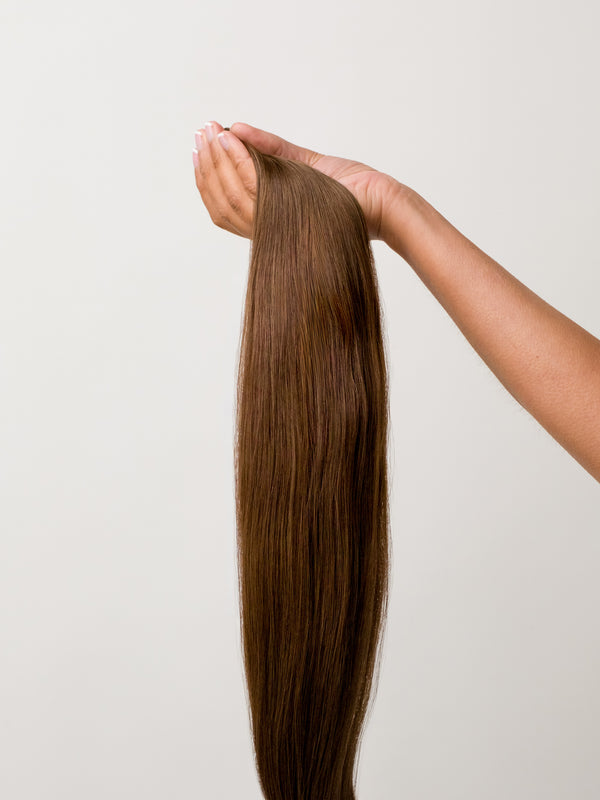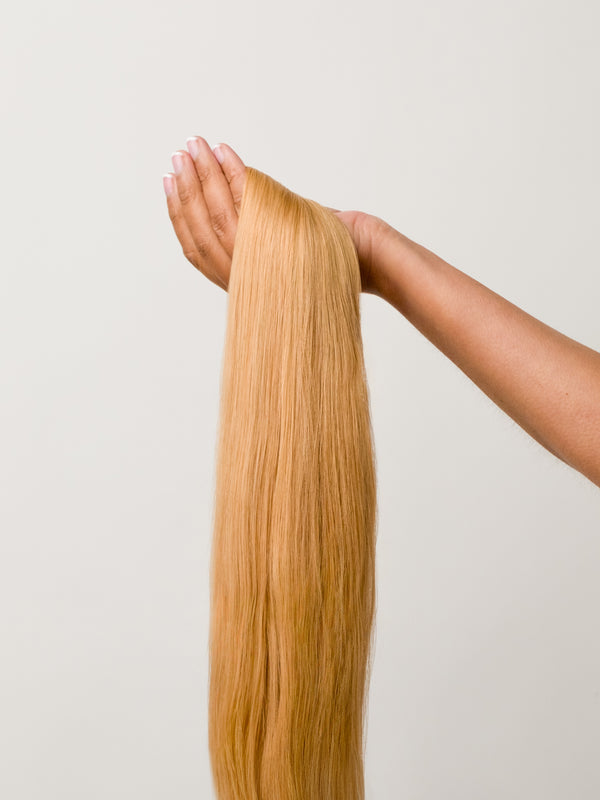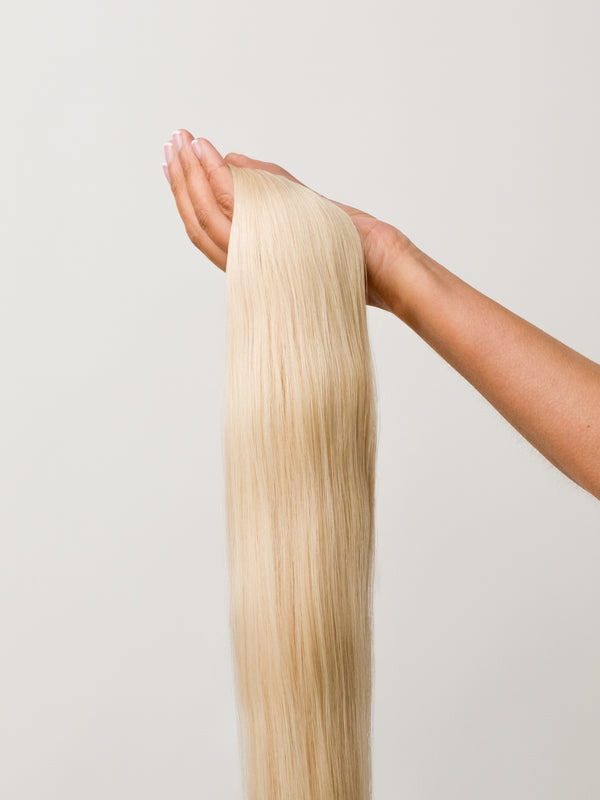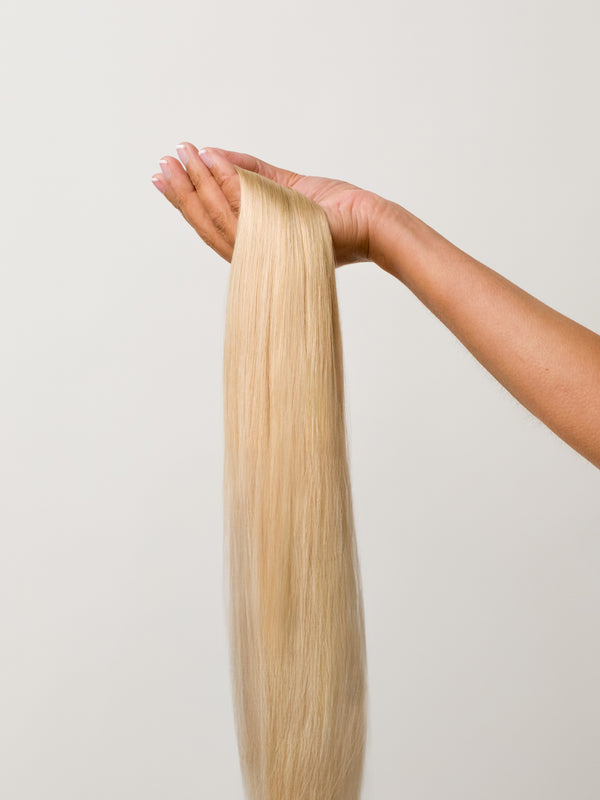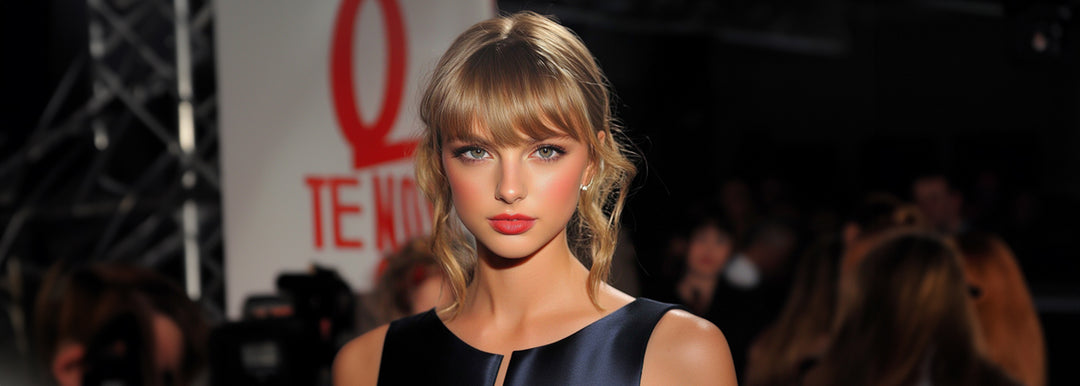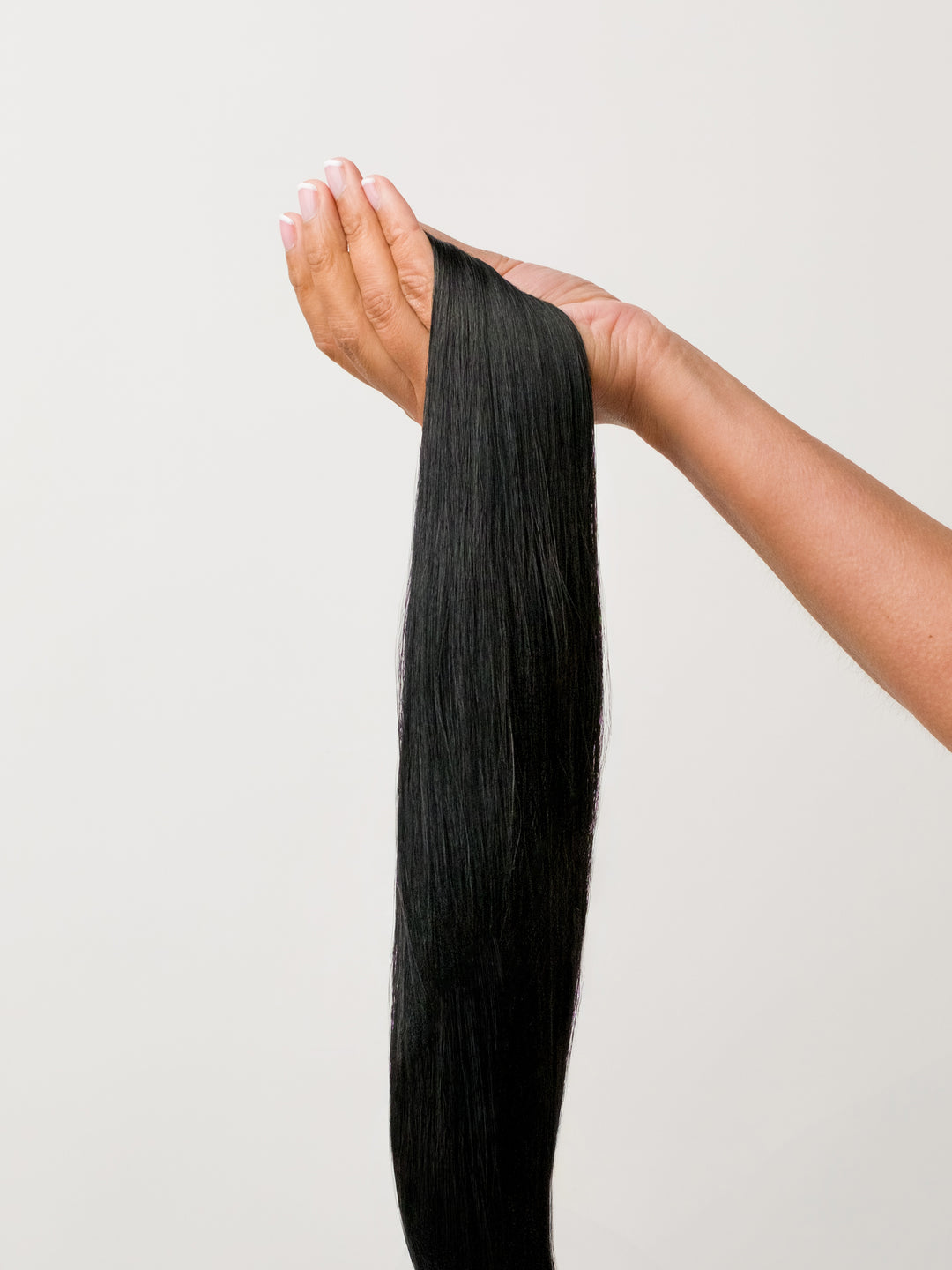Getting hair extensions is kind of like starting a new relationship - it's exciting at first, and you want it to last. But just like any relationship, making those extensions stick around takes a bit of effort and commitment.
I'm going to share some tips on how to take care of your hair extensions so they look amazing for as long as possible. We'll cover everything from choosing the right products to gentle styling techniques - the tips and tricks to keep your extensions happy and healthy.
Whether you just got them or you've had them for a while, this guide has got your back. No complicated routines, just some simple hair care routine to help your extensions thrive. Because at the end of the day, the secret to making it last is putting in a little TLC.
Key Takeaways
-
Use a sulfate-free shampoo and conditioner made specifically for extensions
-
Apply a leave-in conditioner or hair oil to add moisture and prevent dryness
-
If using hot styling tools, always use a heat protectant product first
-
Gently brush daily from ends to roots with a soft brush or wide-tooth comb
-
Sleep with hair braided or in a silk/satin scarf to avoid tangles and knots
Types of Hair Extensions
Hair extensions come in two main types - human hair and synthetic hair. Both have their own good and bad points, so the best choice depends on the look you want, your budget, and your lifestyle. Human hair extensions feel luxuriously soft and natural-looking. You can style them with hot tools like straighteners and curling irons, just like your own hair. With proper care, they can last up to a year. They also blend well with most hair types. However, human hair extensions are more expensive than synthetic ones. They need more maintenance to prevent damage and tangling, and may lose their vibrant color over time if you use hot tools frequently.
Synthetic hair extensions are an affordable way to add volume and length. They come in a wide variety of colors and textures, including fun, bright shades. Synthetic extensions generally need less maintenance than human hair. Some types may even hold curls better. The downside is they can look less natural, especially lower-quality synthetic hair. You can't use hot styling tools on them as they may melt or get frizzy. Synthetic extensions also tend to tangle more easily and may not last as long as human hair – just a few weeks to a few months.
To help you decide, choose human hair if you want a natural look, the ability to style with heat, and are willing to take good care of quality extensions. Go for synthetic hair if you're on a budget, want to experiment with bold colors or textures, or prefer a low-maintenance option for occasional wear. Some brands offer blended synthetic extensions that look very close to human hair texture at a lower cost. And if you have an active lifestyle or often use hot tools, human hair may be more durable and heat-resistant.
Proper Installation Hair Extension Techniques
You've got a few options when it comes to getting human hair extensions. Each method has its own way of getting those babies installed. Now, you might be thinking, "Hey, I can totally do this myself at home and save some cash." But listen, it's better to let a pro handle it.
Licensed hairstylists know what they're doing when it comes to applying extensions. They've got the skills to make sure your natural hair doesn't end up getting all jacked up. Trust me, you don't want to risk damaging your own hair just to save a few bucks.
Let me give you the rundown on some of the popular extension methods out there:
Strand-by-Strand (Keratin Extensions Fusion)
This method uses heat to attach individual pre-tipped extensions to small sections of your natural hair with keratin glue. It creates natural-looking volume and length, with the bond lasting 8-12 weeks. However, the heat can potentially damage your hair if not applied carefully. Removal requires breaking the keratin bond using a special tool.
Micro Bead/Link Extensions
With this one, they take those weft extensions - you know, the hair strands woven onto those thin fabric tracks - and secure them to small sections of your natural hair using tiny beads and pliers. The cool thing is, they can place those bead attachments in different ways to blend it in nicely. And for those with finer hair, this method is a bit gentler compared to the fusion technique.
The potential downside though is that sometimes those little beads can be visible, depending on your hair color and style. So you might have to be strategic with how you wear your hair.These extensions need to be tightened again every 4-6 weeks.
Weaves/Sew-in Extensions
First, cornrows (braids) are made along your scalp. Then, hair extensions (wefts) are sewn onto those braids with a needle and thread. This protective style promotes hair growth underneath and adds a lot of length and volume. But it requires skills to braid properly, and if not done right, it can cause tension on your scalp. It may not be suitable for thin or fragile hair.
Tape-in Extensions
These use pre-taped weft extensions that are applied with a medical-grade adhesive to sections of your natural hair. They're quick and easy to install and remove, and gentle on your hair. However, the bonds may not last as long as other methods (4-6 weeks), and the tape might be visible if you have thin hair.
Clip in Hair Extensions
Clip-in extensions are a great temporary option for added volume and length. To install, wash and dry hair first. Separate hair into horizontal sections, clipping top sections away. Position weft extension under a section, aligning clips close to roots without discomfort. Firmly close clips to secure weft, repeating process while working upwards. Style as usual, blending extensions with natural hair.
For best results, match extensions to your hair color. Start with smaller wefts if new to clip-ins. Tease natural hair at clip points for better grip. Use thin hair to cover top clips. Add bobby pins for security with heavy extensions. Clip-ins are easy to DIY, damage-free when applied right, allow experimenting with looks, and offer versatile, commitment-free transformations.
Daily Maintenance Routine
Taking care of your hair extensions is super important if you want them to look beautiful and last a long time. Here are some easy tips to care for your hair extensions properly so that it is tangle-free, healthy, and gorgeous:
Brushing:
-
Gently brush your extensions every day, starting from the ends and working your way up to the roots. Don't tug or pull too hard. Use a soft brush made for extensions or a wide-tooth comb.
-
Split your hair into sections to make it easier to brush without tangling.
-
When brushing near the roots, hold the weft (the extension piece) to support it and avoid pulling on your natural hair.
Moisture:
-
Extensions can't get natural oils from your scalp, so they get dry and frizzy easily. Use a leave-in conditioner or hair oil made for extensions to add moisture and make them smoother.
-
Apply the conditioner or oil on your hair gently from the middle of your hair to the ends. Avoid the roots so you don't loosen the extensions.
Shop Roxy Hair
Sleeping:
-
Before bed, loosely braid your hair or wrap it in a silk or satin scarf. This prevents matted hair and tangles and frizz from rubbing on your pillow.
-
Consider getting a silk pillowcase too - it causes less friction while you sleep. As much as possible don't sleep with wet hair.
Other Tips:
-
Don't use heat styling tools like straighteners too much to straight hair, as heat can damage extension hair. If you do, use a heat protectant spray and keep the temperature low.
-
Avoid tight hairstyles like ponytails or buns that pull on the extensions. Wear your hair loose or use soft hairbands.
-
Chlorine and saltwater can dry out extensions, so wear a swim cap. Rinse extensions with fresh water after swimming and use a leave-in conditioner.
Washing and Drying Hair Extensions
Washing your hair extensions is really important for keeping them hygienic and preventing tangling or matting. The process is a little different from washing your natural hair though. Here's a guide on how to keep those extensions clean and looking their best:
Frequency
For clip-in extensions, wash them every 10-15 wears or when you notice product buildup making them feel dirty. If your extensions are sewn or bonded into your natural hair, wash them as often as you wash your own hair, which is typically once a week. However, some stylists recommend washing bonded or sewn-in extensions every 1-2 weeks.
Preparation
Grab a nice, gentle shampoo and conditioner made for extensions - no harsh sulfates in those. You'll also want a wide-tooth comb to be extra gentle, and a microfiber towel to dry off. A spray bottle with some cool mist can help too if you've got one handy. Oh, and if you're rocking clip-ins, take those out before getting your wash on.
Washing
Before getting those extensions wet, use a wide-tooth comb to gently detangle them from the bottom up. Fill the sink with lukewarm water - nothing too hot or it could mess up the extensions. Add a little shampoo and lightly massage it into your scalp for bonded ones, or the wefts if they're sewn-in. No harsh scrubbing, just be gentle. Coat the middle and ends with a good amount of conditioner and let it soak in for 5-10 minutes to really hydrate the extensions. Finally, rinse everything out with cool water until all the shampoo and conditioner is gone.
Drying
You gotta be gentle when drying your extensions. Rough stuff like blow drying on high heat or rubbing them dry with a regular towel can lead to frizz and damage. Not a good look.
Instead, after washing, gently squeeze out the excess water using a microfiber towel. Don't twist or wring the hair, just a gentle squeeze. The best way to dry them is to let them air dry completely in a cool, well-ventilated area.
If you're in a rush, you can use a blow dryer on the coolest setting. But keep that thing at least 12 inches away from your hair and use your fingers to diffuse the air flow. This prevents heat damage.
Products to Use For Longer Hair Extensions
Here are some hair extension care tips to keep them looking awesome:
First up, ditch those regular shampoos with sulfates. That stuff can dry out your extensions like crazy. Get a sulfate-free shampoo and conditioner made specifically for extensions instead. It'll be way gentler.
After you wash your hair, use a leave-in conditioner too. It adds extra moisture to keep those extensions silky smooth all day long. You can reapply it later if they start feeling dry.
If you use hot tools, spray on a heat protectant first. Otherwise, that high heat will make your extensions a frizzy, brittle mess. Not cute!
Tangles are bound to happen, so get yourself a good detangling brush and wide-tooth comb. The brush lets you work through knots gently from the ends up. The comb is perf for getting through wet hair fresh from the shower and prevent tangling.
Oh, and hair oil is a game-changer for adding shine and smoothing frizz on dull strands like on blonde extensions. Just use a tiny bit on the mid-lengths and ends, otherwise you'll look greasy.
Little tricks - sleep on a silk or satin pillowcase to avoid tangles overnight. And use soft, stretchy hair ties so you don't cause any breakage when putting your hair up.
If you can, replace extensions regularly. And treat your extensions with hair mask once in a while.
Summary
Getting hair extensions to last takes some care. Choose human hair for heat styling or affordable synthetic options. Get them professionally installed - don't DIY. Gently brush daily and use a leave-in conditioner or hair oil for moisture. Wrap hair at night. Wash weekly/bi-weekly with sulfate-free products made for extensions. Avoid excess heat. Use detangling brushes, heat protectant if styling, and hair oil for shine. With proper techniques and products, your extensions can stay gorgeous longer.
Frequently Asked Questions (FAQs)
What's the difference between human hair and synthetic hair extensions?
Human hair extensions look and feel better, but pricier. Synthetic ones are cheaper, fun colors, but no heat styling and may not look as natural.
How often should I wash my hair extensions?
For clip-ins, wash every 10-15 wears. For sewn or bonded extensions, wash every 1-2 weeks, just like your normal hair.
What hair products should I use for extensions?
Use sulfate-free shampoo and conditioner made for extensions. Also get a leave-in conditioner, heat protectant spray if using hot tools, detangling brushes, and a hair oil for added moisture and shine.
How do I take care of my extensions daily?
Gently brush daily from ends to roots with a soft brush or wide-tooth comb. Apply leave-in conditioner or hair oil to prevent dryness. Sleep with hair braided or wrapped in a silk scarf.
Can I install hair extensions myself at home?
Get a pro to install your hair extensions. Doing it yourself is risky and could damage your real hair.






